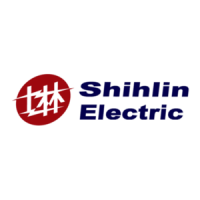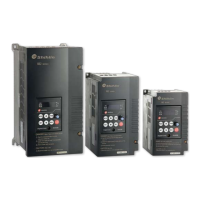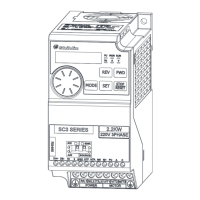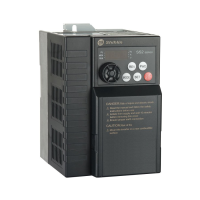General specification
INVERTER INTRODUCTION 19
3.2 General specification
SVPWM control, V/F control, close-loop V/F control (VF+PG), general flux vector control,
sensorless vector control (SVC), close-loop vector control (FOC+PG), torque control
(TQC+PG).
Frequency
setting
resolution
The resolution is 0.01Hz.
0.01Hz/60Hz(terminal 2: -10~+10V/13bit)
0.15Hz/60Hz(terminal 2: 0~±10V/12bit)
0.03Hz/60Hz(terminal 2: 0~5V/11bit)
0.06Hz/60Hz(terminal 4: 0~10V, 4-20mA/12bit)
0.12Hz/60Hz(terminal 4: 0~5V/11bit)
Output
frequency
accuracy
Maximum target frequency±0.01%.
Maximum target frequency±0.1%.
IM: When SVC, 1:200; when FOC+PG, 1:1000.
PM: When SVC, 1:20; when FOC+PG, 1:1000.
Constant torque curve, variable torque curve, five-point curve, VF separation
Acceleration / deceleration curve
characteristics
Linear acceleration /deceleration curve, S shape acceleration /deceleration curve
Induction motor(IM), permanent magnet motor(SPM, IPM)
The stalling protection level can be set to 0~250%
Keypad setting, DC 0~5V/10V signal, DC -10~+10V signal, DC 4~20 mA signal, multiple speed
stage level setting, communication setting, HDI setting.
Please refer to parameter description
Supports 21 basic instructions and 14 application instructions, including PC editing software;
Output frequency, output current, output voltage, PN voltage, output torque, electronic thermal
accumulation rate, temperature rising accumulation rate, output power, Analog value input
signal, digital input and output terminal status…; alarm signal and alarm history 12 groups at
most
Forward rotation indicator, reverse rotation indicator, frequency monitoring indicator, mode
switch indicator ,PU control indicator, PLC indicator and run indicator
Built-in Shihlin/Modbus communication protocol, can select MODBUS TCP,CANopen、
Profibus、DeviceNet、EtherCAT card
Protection mechanism /
alarm function
Output short circuit protection, Over-current protection, over-voltage protection, under-voltage
protection, motor over-heat protection, IGBT module over-heat protection, communication
abnormality protection,
Heavy load :-10 ~ +50℃ (non-freezing), Light load:-10 ~ +40℃ (non-freezing), please refer
to 3.4.2 Class of protection and operation temperature for details.
Below 90%Rh (non-condensing).

